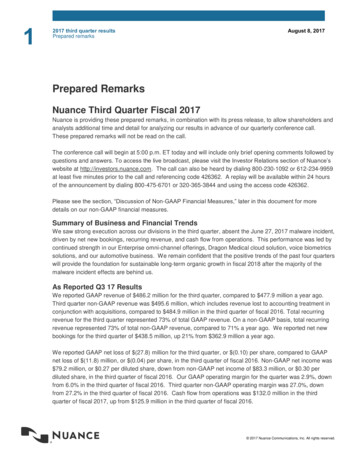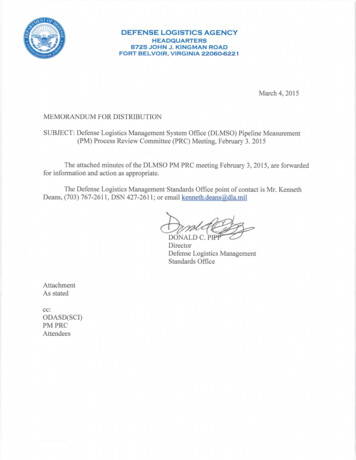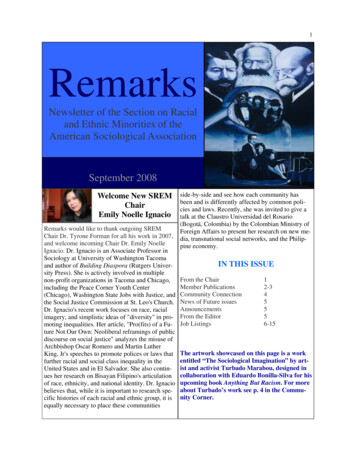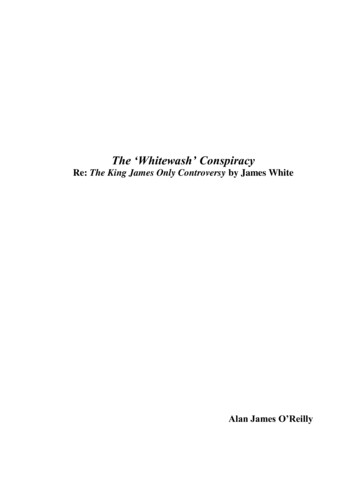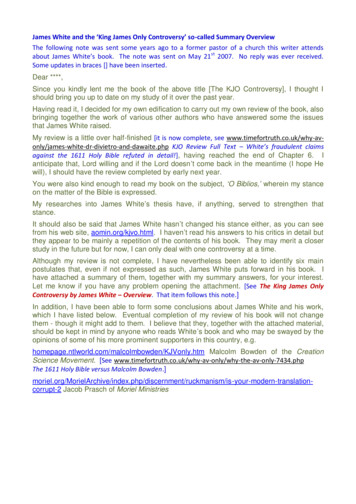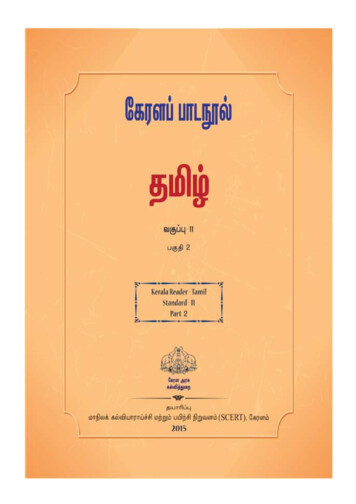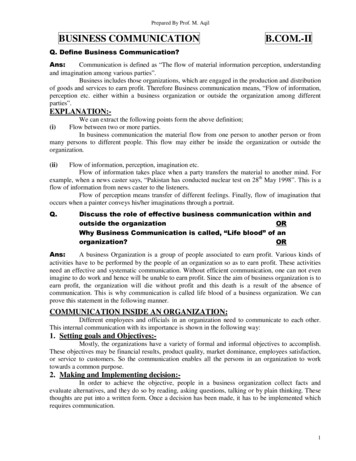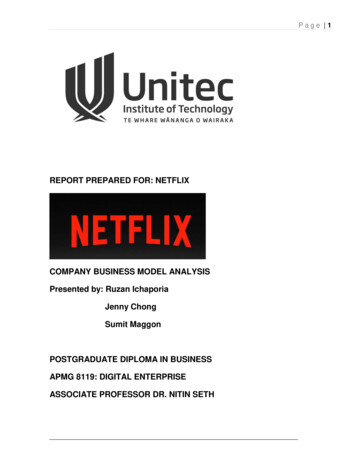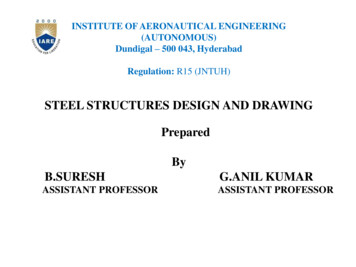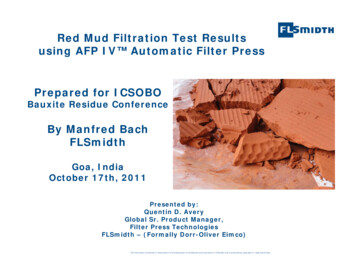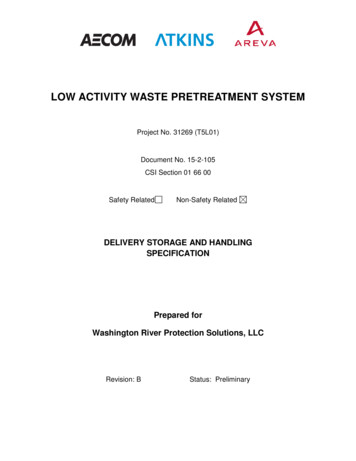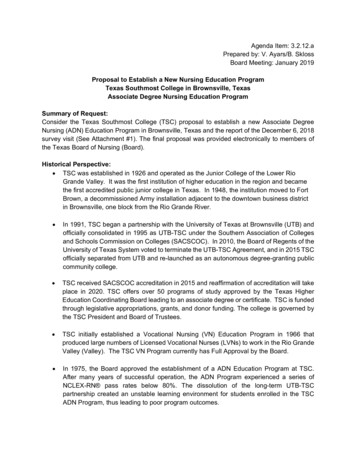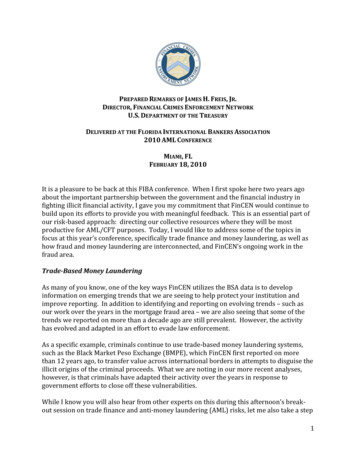
Transcription
PREPARED REMARKS OF JAMES H. FREIS, JR.DIRECTOR, FINANCIAL CRIMES ENFORCEMENT NETWORKU.S. DEPARTMENT OF THE TREASURYDELIVERED AT THE FLORIDA INTERNATIONAL BANKERS ASSOCIATION2010 AML CONFERENCEMIAMI, FLFEBRUARY 18, 2010It is a pleasure to be back at this FIBA conference. When I first spoke here two years agoabout the important partnership between the government and the financial industry infighting illicit financial activity, I gave you my commitment that FinCEN would continue tobuild upon its efforts to provide you with meaningful feedback. This is an essential part ofour risk-based approach: directing our collective resources where they will be mostproductive for AML/CFT purposes. Today, I would like to address some of the topics infocus at this year’s conference, specifically trade finance and money laundering, as well ashow fraud and money laundering are interconnected, and FinCEN’s ongoing work in thefraud area.Trade-Based Money LaunderingAs many of you know, one of the key ways FinCEN utilizes the BSA data is to developinformation on emerging trends that we are seeing to help protect your institution andimprove reporting. In addition to identifying and reporting on evolving trends – such asour work over the years in the mortgage fraud area – we are also seeing that some of thetrends we reported on more than a decade ago are still prevalent. However, the activityhas evolved and adapted in an effort to evade law enforcement.As a specific example, criminals continue to use trade-based money laundering systems,such as the Black Market Peso Exchange (BMPE), which FinCEN first reported on morethan 12 years ago, to transfer value across international borders in attempts to disguise theillicit origins of the criminal proceeds. What we are noting in our more recent analyses,however, is that criminals have adapted their activity over the years in response togovernment efforts to close off these vulnerabilities.While I know you will also hear from other experts on this during this afternoon’s breakout session on trade finance and anti-money laundering (AML) risks, let me also take a step1
back to discuss some of the work FinCEN has done in this area. More than 12 years ago - inNovember 1997 - FinCEN began highlighting trade-based money laundering, specificallythe BMPE, used by drug cartels to launder the proceeds of narcotics sales. 1As FinCEN explained in its advisory issued at the time, the BMPE was a mechanism for drugcartels to maneuver around the Bank Secrecy Act reporting requirements in an attempt tolaunder the cash proceeds of narcotics sales within the United States. At the same time, tocircumvent Colombia’s restrictive policies on currency exchange, Colombian importers(many of whom otherwise were legitimate businesses) bypassed government levies bydealing with peso brokers that dealt in the black market or parallel financial market.Colombian drug traffickers took advantage of this black market method to receiveColombian pesos in Colombia in exchange for U.S. drug dollars located in the United States.2FinCEN’s advisory highlighted for banks and other depository institutions potentialindicators of this activity, to help U.S. financial institutions and businesses identify thisactivity to aid in law enforcement investigative efforts.FinCEN followed up with another advisory in June 1999 to convey the ongoing concern ofFederal law enforcement agencies about the use of the BMPE. 3 The advisory noted thatwhile the initial focus was the misuse of depository institutions, money launderers werealso placing funds with non-bank money transmitters, with the funds destined for pesoexchange transactions.The Federal Financial Institutions Examination Council BSA/AML Examination Manual,issued in collaboration with FinCEN in 2005 and twice updated subsequently, includes asection providing guidance to examiners on assessing the adequacy of bank systems tomanage the risks associated with trade finance activities, and bank management’s ability toimplement effective due diligence, monitoring, and reporting systems.4 Clarifications tothis section in the Manual’s subsequent revisions benefited significantly from industryfeedback through the Bank Secrecy Act Advisory Group, including valuable andconstructive feedback from FIBA.In a June 2006 report, the Financial Action Task Force (FATF) named trade-based moneylaundering as an increasingly important money laundering and terrorist financingvulnerability.5 The report noted that trade-based money laundering methods varied intypology from the most basic to very complex schemes. Basic schemes includedmisrepresenting the price and quantity of goods and services (over-and under-invoicing), andSee http://www.fincen.gov/news room/rp/advisory/pdf/advisu9.pdfThe Black Market Peso Exchange facilitates the “swap” of dollars owned by drug cartels in the United Statesfor pesos already in Colombia, by selling the dollars to Colombian businessmen who are seeking to buy UnitedStates goods for export. See FinCEN Advisory Issue 9, Colombian Black Market Peso Exchange, November,1997. See also the “2007 National Money Laundering Strategy,” Chapter 6, Trade-Based Money s/nmls.pdf.3 See http://www.fincen.gov/news room/rp/advisory/pdf/advis12.pdf4See http://www.ffiec.gov/bsa aml infobase/pages manual/manual online.htm5 See df122
invoicing the same goods or services more than once (double invoicing). The illicit activity washidden in part by the enormous volume of international trade transactions.According to the 2009 International Narcotics Control Strategy Report (INCSR), it isestimated that the annual dollar amount laundered through trade ranges into the hundredsof billions.6 Additionally, U.S. Immigration and Customs Enforcement (ICE) reports thattheir trade-based money laundering case initiations have increased by 348 percent since2004.7A key investigative tool for law enforcement to identify potential trade-based moneylaundering activities are the Suspicious Activity Reports (SARs) that financial institutions,including many represented in this audience, file with FinCEN. Law enforcement’s effectiveuse of this tool, however, rests upon their ability to readily identify the nature of thereported activity. In many SAR filings that ultimately have been determined to be relatedto trade-based money laundering, however, FinCEN has seen inconsistent identification ofthat activity. For example, the use of the term “trade-based money laundering” or “TBML”as a key phrase in the narrative is sometimes missing.So today, FinCEN is issuing an advisory to financial institutions to provide updatedguidance to assist in their recognition of possible trade-based money laundering activityand in providing valuable information to law enforcement.8 This includes recommendedkey terms and phrases to be used in the SAR narrative. The consistent use of these terms isimportant for law enforcement officials when they query the BSA database or when the U.S.government reviews the aggregate data when conducting threat assessments.This advisory also identifies activities that may be associated with trade-based moneylaundering as noted through a FinCEN initiative, working with the National DrugIntelligence Center (NDIC) and ICE’s El Dorado Task Force9. These red flags may bedirectly linked to a misrepresentation of price, quantity or quality of merchandise involvedin a trade transaction processed through a financial institution. Although the activitiesfrom this study were specifically focused on trade with Central and South America,financial institutions should consider how to apply these indicators to analogous risksglobally.Also, please keep in mind that the red flags included in the advisory identify only possiblesigns of illicit activity and must be considered in conjunction with the normal transactionactivity expected for the individual customer. In particular, any of these red flags seen inconjunction with shipments of high dollar merchandise (such as electronics, auto parts and2009 International Narcotics Control Strategy Report, Volume II: Money Laundering and Financial Crimes,27 February 2009, 6537.htm.7 The relationship, if any, between this increase and the allocation of ICE resources dedicated to the detectionand investigation of TBML is unknown.8See http://www.fincen.gov/statutes regs/guidance/pdf/fin-2010-a001.pdf9 ICE’s El Dorado Task Force consists of members from more than 55 law enforcement agencies in New Yorkand New Jersey working in partnership to target vulnerabilities and financial crimes in the New York/NewJersey metropolitan area, such as commodity-based money laundering.63
precious metals and gems) to duty free trade zones, such as in the Colon Free Trade Zone inPanama, could be an indication of a trade-based money laundering or black market pesoexchange activity. The list of red flags includes: Third party payments for goods or services made by an intermediary (either anindividual or an entity) apparently unrelated to the seller or purchaser of goods.This may be done to obscure the true origin of the funds. Amended letters of credit without reasonable justification. A customer’s inability to produce appropriate documentation (i.e., invoices) tosupport a requested transaction. Significant discrepancies between the descriptions of the goods on the transportdocument (i.e., bill of lading), the invoice, or other documents (i.e., certificate oforigin, packing list, etc.).Other potential red flags for trade-based money laundering or black market peso exchangeare included in more detail within the advisory, which can be found on FinCEN’s website.In order to assist law enforcement in its effort to target trade-based money laundering andblack market peso exchange activities, FinCEN requests that financial institutions check theappropriate box in the Suspicious Activity Information section of the SAR form and includethe abbreviation “TBML”10 or “BMPE”11 in the narrative portion of all relevant SARs filed.The narrative should also include an explanation of why the institution suspects, or hasreason to suspect, that the customer is participating in this type of activity.Intersection of Fraud and AMLI would like to turn now to the issue of fraud, which I know was also a topic of discussion atthis morning’s panel session.When I spoke here two years ago, I mentioned that FinCEN had recently begun a new typeof outreach to a variety of institutions to help broaden our understanding of financialindustry practices, as well as what information institutions need in order to effectivelyimplement their AML programs. We began then with some of the largest depositoryinstitutions in the United States, and this week some of the FinCEN team will continue themost recent outreach phase of one-on-one meetings with smaller depository institutions.FinCEN found during the course of that outreach to large depository institutions in 2008that generally speaking, the money laundering-related SAR process is managed within abank’s AML or BSA compliance group, while the fraud-related SAR processes are typicallyhandled by other business lines within the bank, including corporate security, fraud1011Trade-based money laundering (TBML).Black Market Peso Exchange (BMPE).4
prevention, loan risk and recovery, consumer lending operations, and credit cardoperations.12As I discussed at another meeting with Florida bankers a year and a half ago,13 FinCEN’swork in this area illustrates that while fraud and money laundering are often viewed asseparate criminal enterprises, acts of fraud and acts of money laundering are often quiteinterconnected. Because the financial gain of the fraudulent activity ultimately needs to beintegrated into the financial system, money laundering is often a product of fraud.From a due diligence perspective, information financial institutions have available andcollect to comply with their anti-money laundering program requirements in many waysmirrors the information they would already be gathering for anti-fraud purposes.Customer and transactional information used for AML purposes is often the same customerand transactional information needed for fraud investigations. As a result, the resourcesbeing spent on fraud detection and prevention within financial institutions may wellsupport the AML program, and vice versa.FinCEN further discussed the interconnectedness of criminal activity in an analytical studywe released in March 2009, which looked at the relationship between mortgage fraud andother financial crime, and identified how financial crime runs through the differentfinancial sectors.14Information Sharing to Fight FraudBecause of the connection between fraud and money laundering, information sharingbetween financial institutions in cases of suspected fraud is critical. We recognizednonetheless that some banks in the United States were hesitant to share information underthe 314(b) program as it related to transactions involving proceeds of suspected fraud.15As a result, on June 16, 2009, FinCEN issued guidance to clarify the scope of permissiblesharing covered by the section 314(b) safe harbor.The guidance is addressed to the provision that permits financial institutions, uponproviding notice to FinCEN and using procedures designed to safeguard the information, toshare information with one another. The guidance clarifies that the sharing of informationis permitted to identify and report activities, such as suspected fraud - or other specifiedunlawful activities (SUAs) (the predicate offenses for money laundering) - if they suspectthere is a nexus between the suspected fraud or other SUA and possible money launderingor terrorist financing activity.1612FinCEN’s full Report on Outreach to Large Depository Institutions (October 2009) may be found athttp://www.fincen.gov/news room/rp/repor
18.02.2010 · 2010 AML CONFERENCE. MIAMI, FL . FEBRUARY 18, 2010 . It is a pleasure to be back at this FIBA conference. When I first spoke here two years ago about the important partnership between the government and the financial industry in fighting illicit financial activity, I gave you . my commitment that FinCEN would continue to . build upon. its efforts to provide you with meaningful feedback. This .
